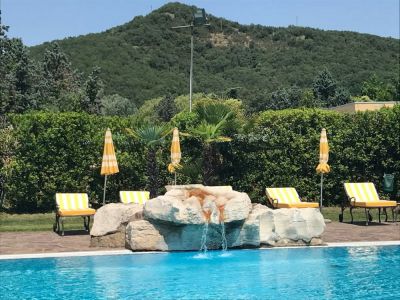How do you reconcile preserving a beautiful unknown and unspoiled area with attracting more tourists and expanding tourism to help the local economy?
This is the problem faced by the Colli Euganee (Euganean Hills), a lovely area of extinct volcanoes, hot springs and vineyards which is virtually unknown as a tourist destination, yet only 30 miles from Venice. Even the name is a problem. They are thinking of advertising as ‘The Venetian Hills’ to attract more visitors.
Until recent years, the area was famous throughout Italy for its mud therapy because of the remarkably rich mineral content of the mud. Italian workers came here up to the 1960s for a week’s annual cure as part of their National Health insurance scheme (INPS), and the buildings still exist which accommodated them, such as the fascist-style architecture of the building in the thermal park at Battaglia Terme, where 300 people a week would stay each summer, 2 weeks for men, and every third week for women. Now that this has ended, and the ‘cure’ is no longer available, only the luxury spa hotels have survived, but they are struggling and face the need to change direction.
Not only is the region stunningly beautiful in its own right; it also has very many attractions for visitors, including several villas, an abbey, one of the top five gardens of Italy, an enormous castle, the home of the poet Petrarch, museums, and a historic canal built in the 13th century to carry the stones which pave Venice. But how to attract more tourists of the ‘right kind’ is the question.
Since the pandemic, various groups have been meeting to discuss the way forward. Covid 19 presented the final blow to the old spa therapy tourism and many family hotels have closed, unable to sustain falling numbers. However, there is light on the horizon.
One of the villas, the beautiful pre-Palladian Villa dei Vescovi, is a member of FAI, the Italian equivalent of The National Trust (to which it is affiliated). This attracts overseas members who have reciprocal rights of entry. Roberta Sereno, an authoritative local guide, has been discussing and coordinating meetings with owners and managers of other important buildings as well as hotel managers, to extend FAI membership so that all can benefit from the extra publicity and discounts. Arrangements to finalize this agreement are already in an advanced stage for the newly reopened Villa Emo Selvatico which has undergone extensive restoration including a tunnel through the hill on which it stands, to a lift to gain entry to the villa, thus avoiding the off-putting hundred plus elegant stairs to the main entrance and making it more accessible to elderly visitors.
Publicity is what the area badly needs. Nothing in Italy seems to be planned on a large scale, perhaps because every local authority is responsible for its own policies, so setting up a coordinated response is a must. Guidebooks and touring Italy websites rarely mention the Euganean Hills: to find out more from the internet, you first need to know what to look for. Visitors to Venice tend to stay where they are rather than venturing into the Veneto. Catajo Castle seems to be improving its status as a major attraction by combining visits with a boat trip along the canal from Battaglia, and this idea has just been extended to canal trips from Padua to the castle, as an alternative to the well-established sailings along the Brenta Canal from Venice to Padua. It is in its early days, but this could eventually bring in many ‘culture vultures’.
A longer-term canal project is now becoming a possibility. In 1932 Mussolini opened a huge lock which used innovative hydraulics to raise or lower large boats 25 feet from the upper to the lower canal at Battaglia Terme. Unfortunately, it was constructed at a time when canal transport had had its day and had become redundant by the 1950s. This year
the lock has reopened, an attraction in its own right, but also a means of linking tourist boats to the Venetian Lagoon from local hills or further afield.
Next problem. How do you market a landscape? Everyone is familiar with the Tuscan landscape with its rolling hills and poplars, but this is entirely different: a group of symmetrical conical hills emerging abruptly from the flat North Italian Plain, vineyards on the southern slopes and chestnuts facing north.
This is a perfect area for ‘slow tourism’. The roads are narrow, often steep and with hairpin bends, ideal for cycling, not cars. Carmen Gurinov is the owner of the sustainable tourism company known as Viaggiare Curiosi, based in Montegrotto Terme. She has built up her business from a few bicycles to a whole fleet, including electric bikes and vans to transport them. Business is looking good. Her husband has left his job to join her, and they have more bookings for guided excursions than they can handle. Last year the Giro d’Italia zoomed through the Euganean Hills, which gave cycling in the area an added impetus.
Many local farms have become agriturismi, offering snacks with a view, to cater for hungry hikers and cyclists, or bed and breakfast to off-the-beaten-track tourists. The area has leaflets, maps and online information translated into English for 17 fantastic walks (circular walks round conical hills) graded for difficulty and ranging from 3 to 10 miles in length. At the moment you can still follow one of these trails and not see another human being, but instead see buzzards gliding, examine the rare wildflowers and butterflies, and on a clear day, enjoy a view of a distant Venice in a sparkling sea on the horizon. There is plenty of room for expansion without spoiling the sensation of being in a world where time has stood still, and nothing has changed for over 200 years.



